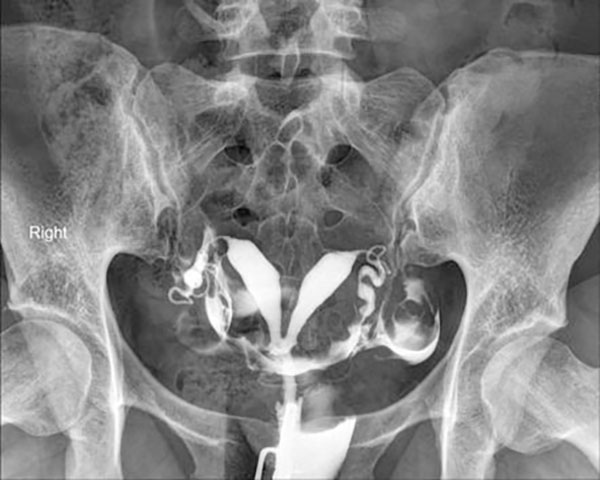- Home
- HSG scan in chennai
Hysterosalpingogram - HSG Scan in Chennai
HSG Test: An X-Ray to test Woman’s Fertility
Painless HSG test. Experienced Lady Doctors and Technicians. HSG TEST DONE ALL DAYS. IMMEDIATE REPORTS. NO WAITING TIME !!! 30 YEARS EXPERIENCE IN HSG REPORTING.
An HSG is a type of imaging test that uses dye and X-rays to check if the fallopian tubes are open and if the shape of the uterus is normal. However, it is important to note that an HSG test is not a direct measure of fertility, but rather an evaluation of the structures that are necessary for conception to occur.
A hysterosalpingogram, or HSG test is an important test of female fertility potential. The HSG test is a radiology procedure usually done in the radiology department of a hospital or outpatient radiology facility.
Radiographic contrast (dye) is injected into the uterine cavity through the vagina and cervix.
The uterine cavity fills with dye and if the fallopian tubes are open, dye fills the tubes and spills into the abdominal cavity.
This determines if the fallopian tubes are open or blocked and whether a blockage is located at the junction of the tube and uterus (proximal) or whether it is at the other end of the fallopian tube (distal). These are the areas where the tube is most commonly blocked.
Test panel for Female:
- Hormone assay
- Torch panel
- Thyroid Function Test
- Follicular Monitoring
- Thyroid Imaging
- Pelvic Ultrasound
- Transvaginal Imaging
Test panel for Male:
- Testicular Pathology
- Penile colour Doppler for EDF
- Complete Semen Analysis
- Colour Doppler Imaging for Varicocele
- Hormone assay
What is the HSG Test?
It is important to note that the HSG test can be uncomfortable and may cause cramping or other mild discomfort. Your healthcare provider will provide you with instructions on how to prepare for the test and what to expect during the procedure.
HSG Test Procedure :
- Preparation: You will be instructed to schedule the test for the first half of your menstrual cycle, typically between days 7 and 10. You may be advised to take over-the-counter pain medication, such as ibuprofen, before the procedure to help reduce discomfort.
- Arrival at the testing center: You will be asked to change into a hospital gown and lie down on an X-ray table.
- Placement of a speculum: A healthcare provider will insert a speculum into your vagina, similar to a Pap test, to visualize the cervix.
- Cleaning the cervix: The cervix will be cleaned with an antiseptic solution to reduce the risk of infection.
- Insertion of a catheter: A thin, flexible catheter will be inserted through the cervix and into the uterus.
- Injection of dye: A special dye will be injected through the catheter into the uterus. As the dye flows into the fallopian tubes, X-ray images will be taken to visualize the structures.
- Imaging: You will be asked to hold still while X-ray images are taken of your reproductive system. You may need to change positions or hold your breath briefly during the procedure.
- Completion of the test: Once the images have been taken, the catheter will be removed, and you will be able to change back into your clothes and resume normal activities.
After the HSG test, you may experience some cramping or discomfort, which can typically be managed with over-the-counter pain medication. Your healthcare provider will review the results of the test with you and discuss any further treatment or testing options if necessary.
When Should the HSG Test Be Done?
The HSG (hysterosalpingogram) test is typically performed in the first half of the menstrual cycle, usually between days 7 and 10. This is because the test requires that the woman not be pregnant, and the first half of the menstrual cycle is when the lining of the uterus is thin and the chance of pregnancy is low. It is important to schedule the test during a time when you are not menstruating or experiencing any signs of infection, such as fever or vaginal discharge.
It is also important to discuss the timing of the HSG test with your healthcare provider, as they may have specific recommendations based on your individual situation. For example, if you have irregular periods or are taking medication to induce ovulation, your healthcare provider may need to adjust the timing of the test.
In general, the HSG test is recommended for women who are having difficulty becoming pregnant or who have a history of reproductive problems, such as recurrent miscarriages or pelvic infections. Your healthcare provider may also recommend the HSG test as part of a routine fertility evaluation.
If you are planning to have an HSG test, be sure to discuss any concerns or questions you have with your healthcare provider beforehand. They can provide you with more detailed instructions on how to prepare for the test and what to expect during the procedure.
HSG Test Cost in Chennai
For a painless HSG Scan in Chennai, consider Madras Scans & Labs as your go-to destination. It is the most trusted HSG test lab in Chennai with its exceptional and secure diagnostic services at an affordable pricing system.


